August 15
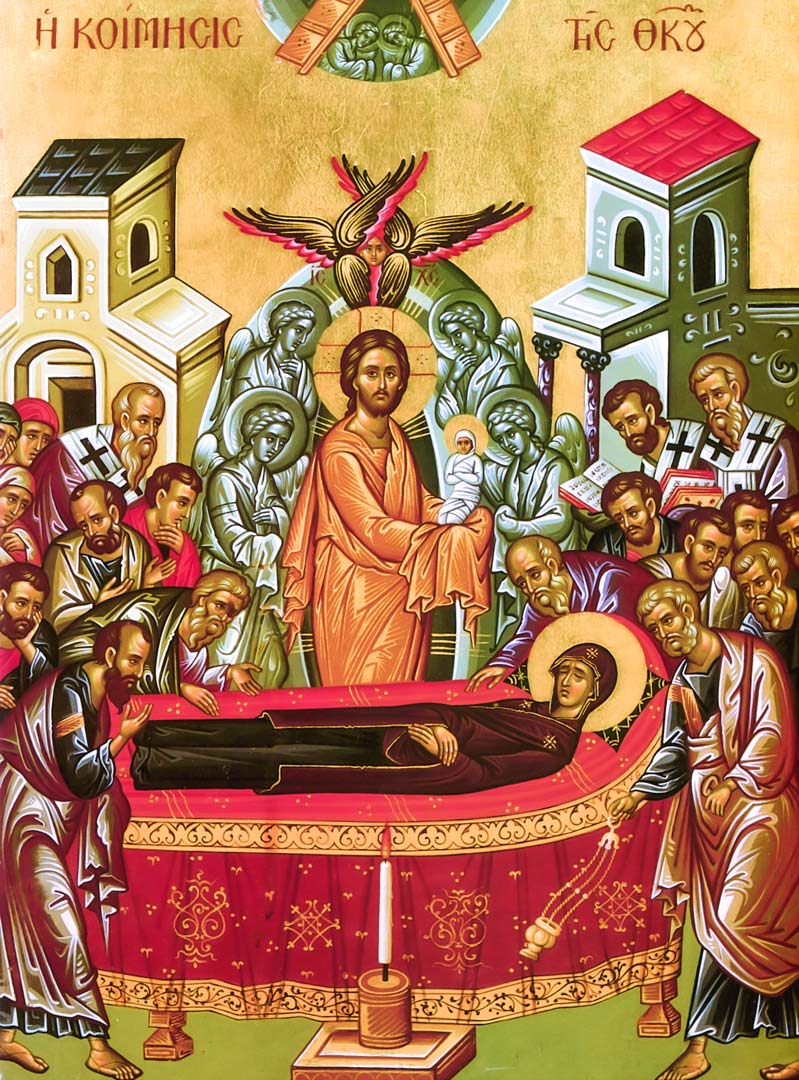
Introduction
The Feast of the Dormition of Our Most Holy Lady, the Theotokos and Ever-Virgin Mary is celebrated on August 15 each year. The Feast commemorates the repose (dormition and in the Greek kimisis) or "falling-asleep" of the Mother of Jesus Christ, our Lord. The Feast also commemorates the translation or assumption into heaven of the body of the Theotokos.
Biblical Story
The Holy Scriptures tell us that when our Lord was dying on the Cross, He saw His mother and His disciple John and said to the Virgin Mary, "Woman, behold your son!" and to John, "Behold your mother!" (John 19:25-27). From that hour, the Apostle took care of the Theotokos in his own home.
Along with the biblical reference in Acts 1:14 that confirms that the Virgin Mary was with the Holy Apostles on the day of Pentecost, the tradition of the Church holds that she remained in the home of the Apostle John in Jerusalem, continuing a ministry in word and deed.
At the time of her death, the disciples of our Lord who were preaching throughout the world returned to Jerusalem to see the Theotokos. Except for the Apostle Thomas, all of them including the Apostle Paul were gathered together at her bedside. At the moment of her death, Jesus Christ himself descended and carried her soul into heaven.
Following her repose, the body of the Theotokos was taken in procession and laid in a tomb near the Garden of Gethsemane. When the Apostle Thomas arrived three days after her repose and desired to see her body, the tomb was found to be empty. The bodily assumption of the Theotokos was confirmed by the message of an angel and by her appearance to the Apostles.
Icon of the Feast
The Icon of the Feast of the Dormition of the Theotokos shows her on her deathbed surrounded by the Apostles. Christ is standing in the center (1.) looking at His mother. He is holding a small child clothed in white representing the soul of the Virgin Mary. With His golden garments, the angels above His head, and the mandorla surrounding Him, Christ is depicted in His divine glory.
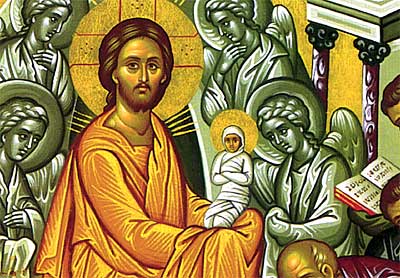
1. Christ, appearing in His Glory, stands in the center of the icon cradling the soul of His Mother, the Theotokos and Ever-Virgin Mary.
The posture of the Apostles direct attention toward the Theotokos (2.). On the right Saint Peter censes the body of the Theotokos. On the left Saint Paul (3.) bows low in honor of her.

2. The Apostles bow their heads in reverence to the Theotokos as Saint Peter (right) censes her body (detail).
Together with the Apostles are several bishops (4.) and women. The bishops traditionally represented are James, the brother of the Lord, Timothy, Heirotheus, and Dionysius the Areopagite. They are shown wearing episcopal vestments. The women are members of the church in Jerusalem.
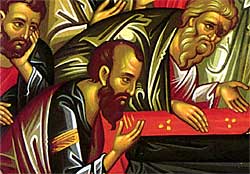
3. The Apostle Paul bows in honor of the Theotokos (detail).
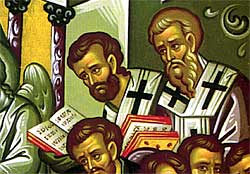
4. Also in attendance to pray for the Theotokos were several Bishops (detail).
In front of the bed of the Theotokos is a candle (5.) that helps to form a central axis in the icon. Above the candle is the body of the Theotokos and Ever-Virgin Mary. Standing over His mother is Christ holding her most pure soul. Above Christ the gates of heaven stand open, ready to receive the Mother of God.
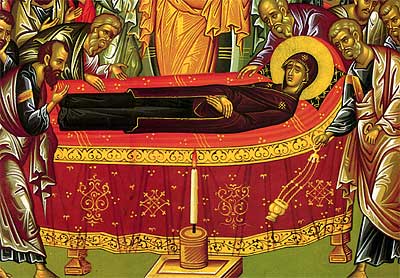
5. The Theotokos lies in the center of the icon surrounded by the Apostles and a candle in front of her bed (detail).
This great Feast of the Church and the icon celebrates a fundamental teaching of our faith—the Resurrection of the body. In the case of the Theotokos, this has been accomplished by the divine will of God. Thus, this Feast is a feast of hope, hope in Resurrection and life eternal. Like those who gathered around the body of the Virgin Mary, we gather around our departed loved ones and commend their souls into the hands of Christ. As we remember those who have reposed in the faith before us and have passed on into the communion of the Saints, we prepare ourselves to one day be received into the new life of the age to come.
We also affirm through this Feast as we journey toward our heavenly abode that the Mother of God intercedes for us. Through Christ she has become the mother of all of the children of God, embracing us with divine love.
Orthodox Christian Celebration of the Feast of the Dormition
The commemoration of the Dormition of the Theotokos and the preparation for the Feast begin on August 1 with a period of fasting. A strict fast is followed on most of the days (no meat, dairy, oil, or wine), with the exceptions of fish on the Feast of the Transfiguration (August 6) and the day of the Dormition. Oil and Wine are allowed on Saturdays and Sundays.
On the weekdays before the Feast, Paraklesis services are held in most parishes. These consist of the Great Paraklesis and the Small Paraklesis, both services of supplication and prayer for the intercessions of the Theotokos.
The Feast of the Dormition is celebrated with the Divine Liturgy of Saint John Chrysostom which is conducted on the morning of the Feast and preceded by a Matins (Orthros) service. A Great Vespers is conducted on the evening before the day of the Feast. Scripture readings for the Feast of the Dormition are the following: At Vespers: Genesis 28:10-17; Ezekiel 43:27-44:4; Proverbs 9:1-11. At the Matins: Luke 1:39-49, 56. At the Divine Liturgy: Philippians 2:5-11; Luke 10:38-42; 11:27-28.
Resources
Icon of the Dormition of the Theotokos provided by Theologic and used with permission.
The Festal Menaion. Translated by Mother Mary (South Canaan, PA: St. Tikhon’s Seminary Press, 1969) pp. 63-65.
The Incarnate God: The Feasts of Jesus Christ and the Virgin Mary, Catherine Aslanoff, editor and Paul Meyendorff, translator (Crestwood, NY: St. Vladimir’s Seminary Press, 1995).
On the Dormition of Mary: Early Patristic Homilies. Translation and introduction by Brian E. Daley, S.J. (Crestwood, NY: St. Vladimir's Seminary Press, 1998).



 AGOC's Facebook Page
AGOC's Facebook Page AGOC's YouTube Channel
AGOC's YouTube Channel
 Get a Call from Santa Claus!!!
Get a Call from Santa Claus!!!